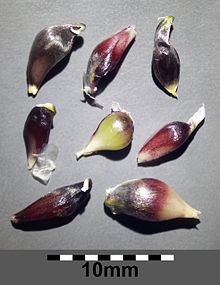Snake leek
| Snake leek | ||||||||||||
|---|---|---|---|---|---|---|---|---|---|---|---|---|

Snake leek ( Allium scorodoprasum ) |
||||||||||||
| Systematics | ||||||||||||
|
||||||||||||
| Scientific name | ||||||||||||
| Allium scorodoprasum | ||||||||||||
| L. |
The snake leek ( Allium scorodoprasum ) is a species of the genus leek ( Allium ).
description
Vegetative characteristics
The snake leek is a perennial herbaceous plant and reaches a stature height of up to 100, occasionally up to 150 centimeters. This geophyte forms onions as persistent organs. The brown- skinned onions reach a diameter between 6 and 10 centimeters. When developing the stem, you create a new onion on the side. The up to 40 centimeters long leaves are rough on the edge and on the median nerve.
Generative characteristics
The flowering period extends from May to August. The inflorescence is surrounded by two long-lasting bracts . The stalked, mostly sterile flower is threefold. The six bracts are purple in color. The stamens are shorter than the purple perigone .
The number of chromosomes is 2n = 16, 24 or 32.
ecology
The pollination is carried out by small insects . Also, self-pollination is possible. Apparently, fruit set rarely occurs. There are plenty of red-brown bulbs in the inflorescence; So there is a pseudoviviparia in which the flower systems are transformed into small, compressed shoot axes. They spread with flowing water, but also through hiding and chance spreading by animals.
Occurrence and protection
The snake leek is widespread throughout Europe including the British Isles , also in western Asia to the Caucasus and, for example, in Syria and Israel.
The snake leek is endangered in the foothills of the Alps ( Red List of Endangered Species ); it is also listed as "endangered" in Lower Bavaria.
The snake leek thrives particularly well in sunny locations on light to medium-heavy soils . He likes to appear in the company of the Querco-Ulmetum from the Alno-Ulmion association, but also in companies of the Fumario-Euphorbion association.
use
The onions of the snake leek can be eaten raw or cooked. They are similar to garlic ( Allium sativum ) in taste , but not as intense. The onions are mainly used in salads.
The onions also have medicinal benefits. They have a digestive and disinfectant effect. Snake leek is used in the treatment of abscesses and amoebic dysentery . The juice from the onions has an insect repellent effect.
Common names
Other names for snake leeks, some of which are only used regionally, are or were: Aberknoblauch, Abrauch, Feldknoblauch und Rockenbollen ( Pomerania ).
See also
literature
- Ruprecht Düll , Herfried Kutzelnigg : Pocket dictionary of plants in Germany and neighboring countries. The most common Central European species in portrait . 7th, corrected and enlarged edition. Quelle & Meyer, Wiebelsheim 2011, ISBN 978-3-494-01424-1 . (Section ecology).
- Allium scorodoprasum at Plants For A Future (Use section).
- Entry in Botanik im Bild / Flora von Österreich 2004 (section description).
Individual evidence
- ↑ a b Erich Oberdorfer : Plant-sociological excursion flora for Germany and neighboring areas. 8th edition, Verlag Eugen Ulmer, Stuttgart 2001, ISBN 3-8001-3131-5 , p. 129.
- ↑ Rafaël Govaerts (Ed.): Allium scorodoprasum - data sheet at World Checklist of Selected Plant Families of the Board of Trustees of the Royal Botanic Gardens, Kew. Last accessed on September 23, 2016.
- ↑ Carl Jessen : The German folk names of plants. Publisher by Philipp Cohen, Hannover 1882, p. 19.
Web links
- Allium scorodoprasum L., snake leek. In: FloraWeb.de.
- Snake leek . In: BiolFlor, the database of biological-ecological characteristics of the flora of Germany.
- Profile and distribution map for Bavaria . In: Botanical Information Hub of Bavaria .
- Allium scorodoprasum L. In: Info Flora , the national data and information center for Swiss flora .
- Data sheet with distribution and photos at Flora Italiana by Schede di Botanica .
- Distribution in the northern hemisphere according to Eric Hultén .
- Thomas Meyer: Data sheet with identification key and photos at Flora-de: Flora von Deutschland (old name of the website: Flowers in Swabia ) .





